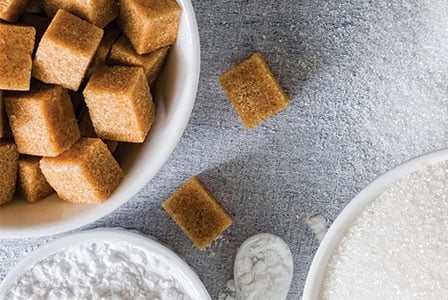
When it comes to health concerns, sugar isn\’t so sweet. To reclaim our health, it\’s time to break up with sugar.
Our love affair with refined sugar began some 10,000 years ago, on the island of New Guinea. The sweet revelation quickly became a panacea, even working its way into mythology about the creation of the human race.
Fast forward to present day where we’ve learned the truth: far from being an elixir, sugar feeds a plethora of disease conditions, including obesity, cancer, diabetes, heart disease, and fatty liver disease—no matter how much you weigh, or sadly, how young you are. It’s been a long relationship, but it’s time to break up.
The skinny on sugar
Sucrose (table sugar) is the most commonly used sweetener in North America. Comprised of 50 percent glucose and 50 percent fructose, this carbohydrate is derived from either sugar cane or sugar beets.
Glucose
The role of glucose is to provide energy for cells, and is a crucial brain fuel. Although not overly sweet to taste, glucose generates an insulin response and has a high glycemic index (GI), which is a measure of the impact that foods have on our blood sugar.
Foods with a lower GI create a slower and steadier rise in blood glucose, while those with a high GI cause a rapid rise in blood glucose resulting in a boost in energy, followed by a dramatic drop and a feeling of sluggishness.
This energy swing is the result of an intricate dance between the glucose you eat and the hormone insulin. Produced by the beta cells of the pancreas, insulin is released into the bloodstream after you eat. Very simply, its role in metabolism is to shuttle glucose into cells.
A condition called insulin resistance occurs when too much glucose is present in the bloodstream and cells stop responding to insulin. The pancreas counters by producing increasingly higher levels of insulin until it reaches maximum output, and blood sugar rises.
Common characteristics of insulin resistance include obesity, especially at the abdomen, hyperlipidemia (high blood cholesterol), and an increased risk of atherosclerotic cardiovascular disease and type 2 diabetes. Alarmingly, these complications are now affecting the youngest members of society.
Fructose
Fructose is the naturally occurring sugar in fruits that provides sweetness, but no insulin response. You might first assume this is good news, but research proves that fructose may be the wolf in sheep’s clothing. While an energy source, fructose is similar to alcohol in that it provides no nutrients.
According to Dr. Robert Lustig, professor of pediatrics in the Division of Endocrinology at the University of California, San Francisco, and author of Fat Chance: Beating the Odds Against Sugar, Processed Food, Obesity, and Disease (Hudson Street Press, 2012), fructose differs from glucose in how it’s metabolized. While all of our cells metabolize glucose, fructose is processed entirely by the liver.
Says Lustig, “Excess fructose is turned into triglycerides, and then one of two things happens. Triglycerides are either packaged into the very low density lipoproteins (VLDL) known to promote cardiovascular disease, or excess fatty acids stay in the liver where they lead to fatty liver disease and promote hepatic insulin resistance.” This, of course, increases risk of weight gain and type 2 diabetes.
The alcohol of children
Lustig is also quick to point out that while obesity is associated with metabolic syndrome, it is not a cause. Although 80 percent of the obese have metabolic dysfunction, you might be surprised to learn that 40 percent of the normal-weight population has metabolic dysfunction and 33 percent of Americans have nonalcoholic fatty liver disease. Some of them are children.
“Sugar is a dose-dependent, chronic hepatotoxin, similar to alcohol,” says Lustig. “Essentially, sugar is the alcohol of children. And just like alcohol, the best treatment is to reduce consumption.”
Hidden dangers
Unfortunately, for many reasons, reducing consumption is easier said than done. First of all, we are exposed to hidden sugars in many of the processed foods we consume on a daily basis, including such unlikely sources as soups, salad dressings, and yogurt. Cutting down on hidden sugar intake, then, requires extreme vigilance while label reading.
On average, in 2004, Canadians consumed the equivalent of 26 teaspoons of sugar, equating to 21.4 percent of total daily calorie intake. More than a third (35 percent) of the sugar consumed by Canadians came from the co-called “other” foods category of Canada’s Food Guide. Sweetened drinks, of course, are among the top sources of sugar.
Are we addicted?
If sugar comes from nonessential or “other” foods, then, why don’t we just opt out? While the logic is clear, the challenge arises due to the addictive nature of our relationship with sugar. Although we have long resisted labelling our love for sugar as an addiction, it’s no longer deniable.
A 2009 study published in Nutrition Journal showed that sweet flavours produce addictive-like behaviours, including withdrawal syndrome, and in 2007, French researchers found that, when given a choice between cocaine or a shot of something sweet, cocaine-addicted rats opted for sugar.
It’s obvious that humans are not immune to the lure of sugar. Lustig explains that sugar triggers the release of dopamine, which binds to dopamine D2 receptors and causes pleasure. More sugar leads to more dopamine and fewer receptors—meaning you need increasing amounts of sugar for decreasing amounts of pleasure. This tolerance phenomenon is part of addiction.
Likewise, because fructose triggers free radical damage, it promotes changes in the reward system of the brain that help to drive overconsumption. Research also shows that a high-fructose diet triggered leptin resistance in rats. Leptin is the satiety hormone, telling our brains we’ve had enough to eat. When the brain no longer responds to leptin, it sends out signals to keep eating.
Breaking the cycle
As Lustig suggests, reducing consumption is the only option to preserve insulin and leptin sensitivity, and stave off the bitter effects of sugar. It’s challenging when we are programmed to enjoy sweetness, and we’re in the habit of eating sugar at will.
If the thought of going cold turkey makes you shiver, consider boosting your intake of fresh, raw fruits and vegetables. Delicious sources of glucose and fructose in healthy ratios, these foods satisfy your glucose requirements and, when you chew them for long enough to impart the full spectrum of flavour, quench your craving for something sweet.
Did you know?
The World Health Organization recommends no more than 10 percent of your daily calories from sugar—below 5 percent for additional benefits. For adults, that would be 25 grams of sugar. A 12 ounce (355 mL) can of Coke contains 39 grams.
Sweet alternatives
When it comes to sugar alternatives, avoid the artificial variety. Research suggests that while your mouth might register an artificial sweetener as sweet, your brain isn’t fooled. If you don’t consume adequate glucose to fuel your brain’s requirements, it will simply prompt you to have more glucose later. In fact, studies show that drinking diet pop increases your likelihood of weight gain more than drinking the regular variety.
When you have a hankering for a cookie or muffin, consider switching out sugar for some more health-friendly options. As with any sweetener, though, use with moderation.
Coconut palm sugar provides the same calorie count as cane sugar, but with up to 79 percent sucrose and only approximately 3 to 9 percent fructose. (Cane sugar is 50 percent fructose.) Read labels to be sure you are getting a pure coconut palm sugar and not a product blended with cane sugar or other sweeteners.
Honey is another natural option that comes with the added bonus of more than 180 substances, including amino acids, antioxidants, enzymes, vitamins, and minerals—but it is also high in fructose, so use sparingly.
Stevia is a virtually calorie-free, zero glycemic index herb that is much sweeter than sugar, so use very sparingly. Look for a brand that doesn’t leave you with a bitter aftertaste.
Maple syrup is a sweet substance derived from the sap of maple trees; it has fewer calories and a lower glycemic load than honey, and is a dietary source of manganese and zinc.
Did you know?
In a study spanning 24 years, researchers determined that children who ate candy daily at age 10 years were significantly more likely to have been convicted for violent crimes at age 34 years.



